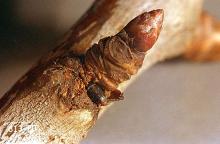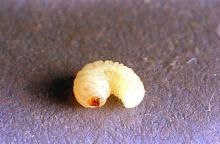Scolytus rugulosus
Pest description and crop damage Shothole borers are small beetles that were introduced to North America and have been found in the PNW since the early 1900s. They are pests of forest trees, ornamental shade trees, and shrubs as well as nut trees. Borers are primarily a problem on injured or stressed plants, but healthy trees growing adjacent to blocks of neglected trees also may be attacked. Chestnut trees growing adjacent to woodlands are also at risk. The adult shothole borer is a brownish-black beetle about 0.08 inch long. The larvae are white, legless, and about 0.17 inch long. Larvae and adults bore into the cambial and vascular tissues of trees, weakening them and causing wilting and dieback of individual stems and branches. Trunks and branches can be completely riddled with galleries.
Biology and life history Shothole borers overwinter as larvae in burrows beneath the bark of infested trees. They pupate there, then adults emerge in spring or early summer, mate, and fly to susceptible trees to feed at the base of leaves or small twigs. They then tunnel into the tree, excavating galleries parallel to the wood grain. They lay eggs along the gallery. The eggs hatch and the larvae feed by tunneling at right angles to the main burrow, causing a characteristic pattern of damage. The burrows are filled with frass and increase in diameter as the larvae mature. After 6 to 8 weeks, the larvae pupate at the ends of the galleries, then emerge as adults starting in August. This activity creates many small, round exit holes that produce a "shothole" effect. There are two generations per year.
Scouting and thresholds Examine branches in late spring for holes 0.08 inch in diameter, oozing sap and sawdust. Beetles are especially attracted to unhealthy trees.
Management-cultural control
Select planting sites with well-drained, slightly acidic soils. The best management tool is keeping trees healthy through proper pruning, adequate watering, and fertilizing. Healthy trees repel the beetles by plugging boreholes with sap and resins. Remove and destroy infested wood on the tree or nearby piles of infested green wood, especially cherry wood. Once the bark on cut wood dries and sloughs off, it is no longer a host for the beetles. Whitewash trunks of young trees to prevent sunburn and reduce potential hazard of attack from shothole borer. Tanglefoot or other sticky substances applied to the trunk may be effective. Yellow sticky traps are effective for trapping these beetles. Lindgren funnel traps can also be effective. Ethanol baits can enhance trap captures.
Management-chemical control: HOME USE
Pesticides must be timed to manage adults and are often not very effective. The best control is preventative. Choose good planting sites, and maintain healthy trees through adequate, but not excessive irrigation, fertilization, and pruning practices, as well as proper sanitation (remove and destroy weak or diseased wood and infested limbs).
Management-chemical control: COMMERCIAL USE
No commercial products are specifically labeled for this pest, but products registered for chestnut with long residuals may be somewhat effective treatments for trunks and branches during flight periods to deter some borers from entering trees.




